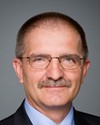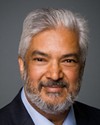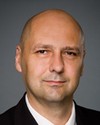My understanding is that we are talking about technological innovation and the treatment of rare diseases. I'd like to address a number of types of technologies and innovations that we feel are really revolutionizing the treatments of rare diseases and, certainly, the presence or the availability of these technologies, but also the application of them, especially in Canada. I think there are some things right now that we are doing very well in Canada, some things where the federal role I think has been especially strong, and then there are some ways in which it could be much better.
If we start by looking at the genetic research in terms of identifying the genetic causes of rare diseases, we see that about 80% of rare diseases do in fact have a genetic cause. Canada currently sits as one of the leading countries in doing this type of research. Certainly, I think it stems from the days when we were still identifying the genes that were in the human genome. Canada built up quite a good repertoire in terms of research technology, but also in terms of laboratories.
The challenge, I think, is that we have not been quite as good in terms of using this genetic knowledge to do screening so that we can identify individuals, from newborns all the way through to older adults, who may have these genetic defects, and certainly in terms of using that information in setting in place programs to prevent harm or to deal proactively with the results of those diseases.
Also, I think we can look at the research and development in understanding the causative pathways in these rare diseases. Really, what is the underlying mechanism by which these diseases happen? Again, Canada sits as quite a leader, I think, certainly very recently with some of the research funding that's come through the CIHR and Genome Canada, and then more recently with the funding that's come through with regard to personalized medicine.
I think the challenge again is our ability to use those to, in this case, develop treatments that are based on an understanding of that causative pathway. Canada, I think, has not really invested in the same way and has not made that as much of a priority. I think the challenge, then, is that we may understand how these diseases work, but we don't necessarily move into having the treatments for them.
I think Canada is beginning to.... I think David Lee is going to talk a whole lot about this. It's much to David's credit, as well as to Health Canada's credit, that we are beginning to develop a very good regulatory framework for the evaluation and the ongoing monitoring of drugs, devices, and other genetic therapies, including things like [Inaudible--Editor] therapies in Canada. The challenge we have again is with the application, that is, in making sure that these innovative technologies are really made available to patients in ways that are safe and monitored and, certainly, made available in a consistent way across the country.
Again, I think that where we have begun to do some things around pharmacovigilance post-market surveillance, we are probably not doing anywhere near the kind of job that's necessary, especially when we recognize how challenging many of these therapies are. I think that in many respects there's still a lot of hesitancy in Canada in terms of using the innovation that we in some respects pioneer here and that we have available. Certainly, I think there are a lot of challenges, because we are such a decentralized access environment, and we end up with the provinces and other jurisdictions that are now responsible for making these therapies available, not just from a purchasing and cost point of view, but in the overall management and monitoring of these therapies.
In some respects, this is where I think from a patient perspective we really would like to see some federal leadership. We feel that the federal government and Health Canada can play a huge role, not necessarily in terms of taking over the provision of therapies or the direct monitoring of therapies, but in providing that leadership role, as it has been in some selective cases, and also in providing for the provinces those kinds of guidance, like national guidelines, etc. Again, I think we've heard the provinces ask for this over and over again, so even within a federated environment, we think the federal government itself could play much more of a leadership role and much more of a guidance role.
I think the other thing we are concerned about in terms of some of the innovation coming in is what to do about therapies that are already in place.
I think Canada is probably very far behind other jurisdictions in being able to approve drugs that have previously been used off label but over time are actually indicated, and have demonstrated to be effective, for a rare disease. In Canada we have a very hard time bringing it into the regulatory framework to provide certainly an on-label indication, to provide the safety and guidance for it. So these drugs continue to be used off label in Canada, whereas in other countries they may actually now be part of the regulated and on-label indication.
One of the challenges for this is not only do we not have the good safety and effectiveness information; in many cases the costs are not reimbursed, because they're not considered to be on-label therapies.
Again, Health Canada could in fact take that role. I don't think they're unaware of it; I think this is something that will take a little bit of redoing. It's urgently important when we recognize that about 50% of the drugs that are used by Canadians with rare diseases are actually used off label. That means there's no regulatory oversight, no actual pathway in which they are managed, and a lot of them are haphazardly reimbursed.
Another area where we're playing a leading role right now is in what we call repurposing drugs—taking drugs that are already on the market or already developed and in many cases being able to reuse them for rare diseases, based on some similar pathways and mechanisms. In terms of risks, certainly, because the drugs in some cases have already been approved and are already in use, there should be in fact a much quicker and a less costly way of making those drugs now available for rare diseases.
We would like to see Canada take a deliberate role in that, in part because we are becoming one of the leaders in research on repurposing drugs—again, through the leadership from CIHR, from Genome Canada, and some of our universities and clinics. It behooves us to also then find a way to bring those onto the market quickly and make them available to patients.
That also speaks to extension for the drugs that are already on the market, oftentimes for rare diseases. As we begin to identify other diseases that have similar pathways, is there a way that we can more quickly make sure that these drugs are also going to be available for other patient populations without having to go back to the same level of clinical trials that the drugs in the original indication required?
We're really quite excited by the fact that Canada seems to be getting into the game here. I think we are looking at our regulatory framework and in some respects at possibly being one of the world leaders once it is in fact put into place, and we hope very soon. Quite frankly, I think Health Canada, certainly with the leadership right now, has been taking the best of what's available internationally and incorporating that into what we're doing. They're also looking into the future: where do we believe rare disease drugs, orphan drugs, will be, and what will they be like?
We're very much a leader, as we've said, in the repurposing of drugs, but also in terms of personalized medicines, which are really very close cousins to these orphan drugs, these drugs for rare diseases.
I think that's very exciting for us in terms of where Canada was just a few short years ago in this whole environment of technology and innovation with regard to rare diseases. We're now moving, I think quite rapidly, to taking what is I think recognized by other countries as well as a leadership position.
I think we're positioned very nicely between Europe and the U.S., and I think both jurisdictions look very much to Canada in terms of not only being part of the game, as we say, but also providing some really good bridging information and maybe in some areas also taking a leadership role.
I'll finish by saying that what we still don't have in Canada, to take full advantage of our innovative technology, is a rare disease strategy. In Europe, the European Union has mandated that every country in the European Union should have a rare disease strategy by the year 2014. Every country is moving towards that.
Canada needs to do that, because without that kind of rare disease strategy, we're not going to take full advantage of some of these innovations; certainly we're not going to do it in a consistent way; we're not going to do it in a way that gets, as we're learning, the most effect out of it; and we're certainly not going to be doing it in a cost-effective way.
Some of that would include things like having centres of excellence, where you can designate centres where you have leading researchers and clinicians who can provide not only the information on diagnosis and research and managing clinical trials, but also can serve as a resource to other clinicians and to other sites in terms of these rare diseases.
I think we need some other things that I think only the federal government can do for us well—a national newborn screening program, for instance, and a national disease registry. We cannot have provincial registries when we're talking about diseases in such small numbers. And to make some of these therapies, these technologies available without good registries—










